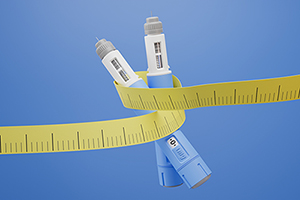



Indeed, portion size, that is. Did you know a New York bagel was about the size of a hockey puck back in the 1970s? Today, it’s equivalent to four or five slices of bread. And if you hollow it out, about three slices of bread. Not much better, right?
 And whatever happened to the 6-ounce cup of brown coffee—the standard for a hot beverage serving? Now, your “grande frappa-mocha-whappa” (your beverage choice) is equivalent to an ice cream sundae. Since when did a plain ol’ cup of joe become a full on dessert, besides tripling in size?
And whatever happened to the 6-ounce cup of brown coffee—the standard for a hot beverage serving? Now, your “grande frappa-mocha-whappa” (your beverage choice) is equivalent to an ice cream sundae. Since when did a plain ol’ cup of joe become a full on dessert, besides tripling in size?
That large “tub” of popcorn at the movies? Do you realize it’s about the size of the wastepaper basket commonly used in your bathroom or home office?
The interesting thing scientific literature reveals is that, most often, we will accept the amount of food or beverage served as the ‘right’ amount – the amount we’re supposed to get. And more often than not, we will finish it! This is the work of Brian Wansink, Ph.D., Professor of Marketing and Nutritional Science at Cornell University. He has proven via his original research, “Why We Eat More Than We Think” (Mindless Eating, New York, NY: Bantam; 2006).
Dr. Wansink has shown that the size of our plates can determine how hungry we feel, and this may explain why we overeat at restaurants. Why restaurants? Look at the size of the plate (or platter!) they serve your entrée on and then compare that to the size of your dinner plates at home. In fact, dinner plates from the 1950s were a couple of inches smaller in diameter than today’s standard dinnerware (9-10 inches vs. 11-12 inches). Dr. Wansink explains that the size of the plate (or popcorn bucket) “can provide subtle but powerful suggestions about how much one should eat.”
Compared to the French, Americans stop eating “when the plate is empty or when the television show they’re watching is over.” The French stop eating when they’re no longer hungry. The difference? The French pay attention to internal satiety cues.
The next time you’re in a restaurant or movie theatre, take a hard look at the portions you’re getting, and compare them to the amounts you would actually serve yourself at home. This exercise alone can change your perception of hunger.
To your health!
Though we think of declining estrogen as the hallmark of menopause, it's actually common for…

Up to 12 percent of Americans have ulcers at some point in life. Peptic ulcers…
Gallbladder disease is a modern illness. An estimated 20 million Americans have gallbladder disease. The…

Dr. Antonio Bianco, recipient of the American Thyroid Association’s John B. Stanbury Thyroid Pathophysiology Medal,…

There’s a misconception among low-carb dieters. Many people believe a low-carb diet is much higher…

New, more powerful weight loss drugs: Drugs like Wegovy, Rybelsus, Ozempic and Mounjaro/Zepbound are revolutionizing…

Q&A with Leyla, Part 1: ‘Good’ Bacteria

Our virtual voicemail is open 24/7, so there's no need to wait to submit your questions for Dr. Hoffman. Leave a message, and you may hear your question featured on the Intelligent Medicine radio program!